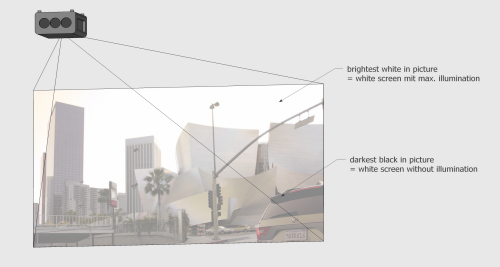
room with high ambience light
same brightness on screen
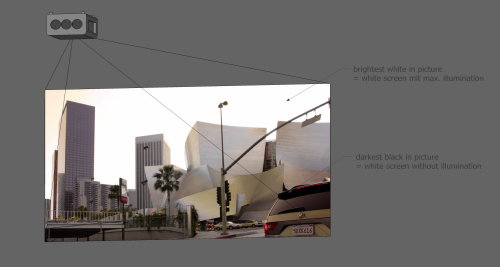
room with low ambience light
same brightness on screen
| Proposed contrast ratios: | basic, non-critical informational viewing | 7:1 |
| viewing requirements for basic decision making | 15:1 |
The visible picture of a projection system is created by light projected on a white surface (projection on grey or colored surfaces follows the same rules). The white surface without projected light equals the darkest black of the picture, the full white light of the projector equals the brightest white of the picture.
The light range between the two scenarios, the darkest black and the brightest white on the screen, is the contrast ratio of the projected picture (this is NOT the contrast ratio of the projector!). That means that the darkest black depends 100% on the ambience light in the room, because this is the illumination of the screen without projection. The brighter the room, the brighter the screen, the less dark is the darkest black in the picture.


The projector creates an image with a contrast ratio 'on top' of the ambience light. With higher ambience light, higher projection light in needed to reach the same contrast ratio (the difference between the darkest and the brightest portions in the image).

The number of ANSI lumens is projector specific and doesn't change with the lens type and the projection distance. The image brightness doesn't change with a different focus and different projection distance!

|
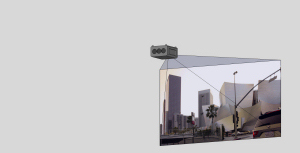
|
| 1000 ANSI Lumen: large focal distance same brightness on screen | 1000 ANSI Lumen: small focal distance same brightness on screen |
The image brightness just changes with he image size! A larger image projected with the same projector (the same number of ANSI lumens) gets darker, the illuminance (lux) diminishes because the screen area gets bigger. The same amount of light is used to illuminate a larger area.
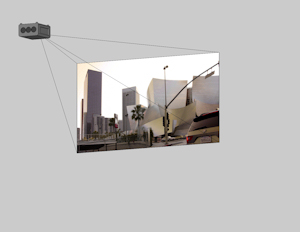
|
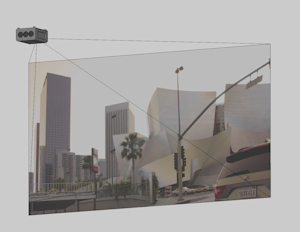
|
| 1000 ANSI Lumen: small strong image 600 lux on screen | 1000 ANSI Lumen: large soft image 300 lux on screen |
The grey scale for tv, display and projector calibration is measured in IRE (Institute of Radio Engineers), there black is 0 IRE and white is 100 IRE. IRE is used to measure composite video signals. The scale represents the color temperature of 6500K (Kelvin) without any color information in any of the grey steps between black and white. 6500K is the equivalent for daylight.

0 IRE represents the blanking level between frames (no picture). A pure black image on analogue NTSC video should have 7.5 IRE, a pure white image will have 100 IRE. In calibrated digital video, the black level is set to 7.5 IRE or 0 IRE as the black cutoff. The 7.5 IRE black level on NTSC video is also called "pedestal". Japanese NTSC is calibrated for 0 IRE as black since 1985 and PAL is also set as 0 IRE for black and 100 IRE for white! Grey scale problems arise when video is converted with incorrect black level.
ISO contrast measurement is defined by the difference between black and white fields in a 4 x 4 arrangement, measuring NIT. The sum of the brightness of all white fields divided by the sum of the brightness of all black fields equals the contrast ratio.
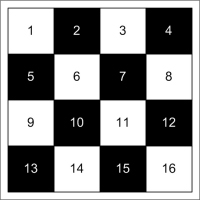
The brightness control on a projector or display actually controls the black level of the display. Tt adds or subtracts an offset to the red, green and blue light output. It should be adjusted in a way that a black area in the displayed image is true black (as black as possible, despite remaining brightness within the black caused by the projection or display technology.
The contrast control is actually a scale or gain factor to the red, green and blue light output. It affects the intensity of the output signal to reproduce a full white signal (luminance).
First brightness should be set correctly then contrast should be adjusted.
| Brightness and contrast can roughly be adjusted (close to perfect) by using two grey scale test patterns (from grey to white and from grey to black). download the two jpg graphic files here or download a MPEG-2 test video (1920x1080i50) here (from this website!) |
 |
After the contrast and brightness is adjusted, the REAL luminous flux (ANSI Lumen) of the projector can roughly be measured. Using a lux meter the ambience light on the projection screen is measured without the projector turned on. After that the same measurement is done with ambient light and the projector turned on.
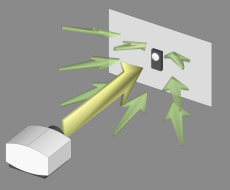 |
 |
 |
 |
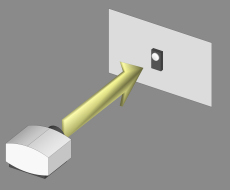 |
| measuring ambient light plus projector light |
measuring only ambient light | the difference equals roughly the projector light output |
The illuminance is the sum of all individual light illuminating a surface. Example: The ambience illumination is 300 lux, the complete illumination is 1300 lux => the illumination caused by the projector is:
1300 lux - 300 lux = 1000 lux. With the known illumination by the projector, the lumen of the projector can be calculated: lumen = lux * square meter.
Example:
measuring ambient light plus projector: 1300 lux
measuring ambient light without the projector: 300 lux
the difference: 1300 lux - 1000 lux = 1000 lux
1000 lux on a 2 square meter screen would correspond to 2000 ANSI Lumen
Stacked projectors are used to get more light output and have redundancy. If one projector fails the other is still running.
The light output of two projectors is the sum of each individual light output: two 5.000 ANSI lumens projectors combine to a 10.000 ANSI lumens device.
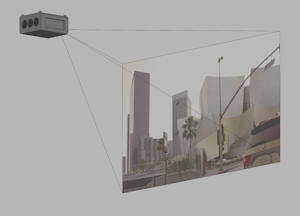
|
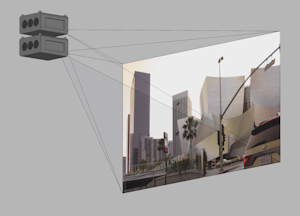
|
| single projector 1000 ANSI Lumens 300 lux on screen | double projector 1000 ANSI Lumens + 1000 ANSI Lumens 600 lux on screen |
The target luminance for a THX theater screen is 16 foot-lamberts, the calibrated luminance in a mastering studio for film work is 35 foot lambert.
Before any measurement the projector should be calibrated to a color temperature of 6500K referring to ISF (Imaging Science Foundation). The color temperature of 6500K is required for the accurate presentation of a video image.
The measurement of foot-lamberts is a measurement related to the brightness of a particular image and is equal to 1 lumen per sq. foot of screen surface. The SMPTE (Society of Motion Picture and Television Engineers) specification for a film-type movie theater is also a minimum of 16 foot-lamberts of brightness.
One foot-lambert equals 3.4262591 candelas per square meter (nits). Candelas per square meters is the newer internationally agreed measurement, but foot-lambert is still used in the movie industry.
InfoComm proposed a new standard for contrast ratios for projected images. It is called "3M-2011". The standards defines: images for purely informational purposes should have a minimum contrast ratio of 7:1, for images to be used for basic decision making a ration of 15:1 and for images for for critical decision making a ration of 50:1 and for full-motion video a ratio 80:1. These are no theoretical numbers from the lab of manufacturers, they are the measured contrast ratios in the final projection environment.
Standard 3M-2011 measurements are based on the ANSI chequerboard. It precisely defines what measurements should be taken and how (five viewing positions).